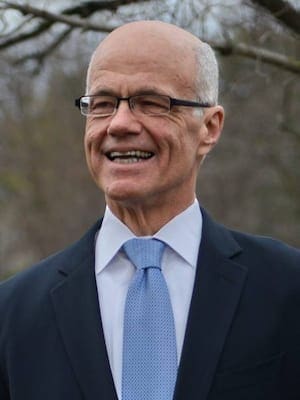In Lewis Carroll’s “Through the Looking Glass and What Alice Found There,” Alice walked through the “wood of no-names,” where individuals didn’t remember their own names and had little awareness of qualities that set them apart from others.
She encountered there a fawn; and, since they couldn’t understand themselves as different from each other, they had no fear of one another.
“So they walked on together though the wood, Alice with her arms clasped lovingly round the soft neck of the Fawn, till they came out into another open field, and here the Fawn gave a sudden bound into the air, and shook itself free from Alice’s arms.
“‘I’m a Fawn!’ it cried out in a voice of delight, ‘and, dear me! you’re a human child!’ A sudden look of alarm came into its beautiful brown eyes, and in another moment it had darted away at full speed.
“Alice stood looking after it, almost ready to cry with vexation at having lost her dear little fellow-traveler so suddenly.”
Harmony was possible in the “wood of no-names” because labeling and categorizing weren’t.
Of course, the peace that prevailed in the “wood of no-names” is easy to question.
Is there really peace if we have simply avoided the distinctions that make us unique? No. Can there be genuine harmony if we don’t deal honestly and respectfully with distinctions? Not really.
The “wood of no-names” invites us, though, to acknowledge and celebrate what we have in common rather than magnify and criticize what separates us.
It’s possible to see one another beyond labels, names, stereotypes and prejudices.
We label one another on the basis of age, appearance and economics: old and young, attractive and unattractive, rich and poor, and upper class, middle class and lower class.
We categorize each other according to race, ethnicity, geography and politics; we divide the human family into tribes, clans and nations, east and west, oriental and occidental, north and south, first world and third world, red state and blue state, and Democrat and Republican.
We stereotype one another on the basis of what we think we know about religion: Judaism, Islam, Buddhism, Hinduism, Christianity and Earth religions, to list only a handful of many.
Christians put each other in theological boxes: Protestant, Catholic and Orthodox; liberal, conservative and moderate; mainline, evangelical and emerging; existentialist, liberationist, feminist and womanist; process, political and narrative; and a host of “posts”: post-Constantinian, post-Enlightenment, postmodern, post-critical and post-evangelical.
What if, at the least, we took the names and labels we have for one another as places for conversation to begin rather than as reasons for it never to start?
What if we turned the assumptions we hold as settled facts into hypotheses, which we tested by actually getting to know one another?
What if we asked to hear one another’s stories, hopes, dreams and fears?
What if we listened with respect, curiosity and openness and spoke with clarity, conviction and civility?
If we did these things, we could walk together with less fear and more compassion – with less conflict and more peace.
 Guy Sayles is a consultant with the Center for Healthy Churches, an assistant professor of religion at Mars Hill University, an adjunct professor at Gardner-Webb Divinity School and a board member of the Baptist Center for Ethics. A version of this article first appeared on his website, From the Intersection, and is used with permission.
Guy Sayles is a consultant with the Center for Healthy Churches, an assistant professor of religion at Mars Hill University, an adjunct professor at Gardner-Webb Divinity School and a board member of the Baptist Center for Ethics. A version of this article first appeared on his website, From the Intersection, and is used with permission.

